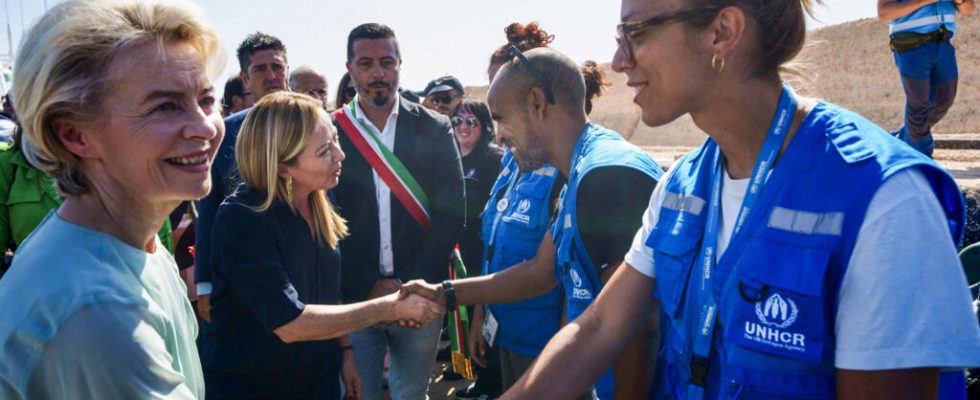This Sunday, September 17, the President of the European Commission Ursula von der Leyen presented on the Mediterranean island of Lampedusa an emergency plan to help Italy manage the record arrival of migrants on its territory.
4 mins
After visiting, with the head of the Italian government, Giorgia Meloni, the reception center for migrants on the small island, this Sunday, September 17, Ursula von der Leyen detailed a ten-point aid plan, intended to manage the current situation, to better distribute applicants between European countries and to prevent the repetition of episodes of mass arrivals which put significant strain on the logistical and administrative capacities of the peninsula. This plan is supposed to combine firmness against smugglers and facilitation of legal channels of entry into the European area for candidates eligible for asylum.
Strengthen Frontex
Brussels first intends to strengthen assistance to Italy from Frontex, the European Union agency for asylum and the coast and border guard agency, in order to ensure the registration of migrants, fingerprinting, interviews, etc. Frontex and other agencies will also have to intensify surveillance of the seas and “ explore options for expanding its naval missions in the Mediterranean “. The commission wants to facilitate the transfer of people arriving in Lampedusa – who are usually taken by boats to Sicily or the continent – including to other European countries.
“ Irregular immigration is a European challenge that needs a European response », insisted Ms von der Leyen during a press point in Lampedusa. “ We urge other Member States to use the voluntary solidarity mechanism “, she said, without mentioning Germany which recently decided to no longer receive migrants arriving in Italy. The plan also plans to improve dialogue with the main emigration countries on this route with a view to the readmission of their citizens who do not meet the asylum conditions, in particular Guinea, Ivory Coast, Senegal and Burkina Faso. Agreements also with countries of origin and transit to curb the number of departures, in particular Tunisia from where the vast majority of people arriving in Lampedusa embark. “ We will decide who enters the European Union and under what circumstances. And not the smugglers and traffickers », summarized the President of the European Commission.
Partnership with Tunisia
In July 2023, the European Union signed a partnership with Tunisia intended to reduce the arrival of migrants on Italian coasts in exchange for financial aid. While Tunisia is going through an intense economic crisis, the EU had offered to put 900 million euros in aid on the table on the condition that Tunisia signs an agreement with the IMF, recalls our correspondent in Tunis, Amira Souilem. Tunisia having refused this clause, the agreement was, in large part, emptied of its content even before its signature. In addition to the component of support for the national economy in exchange for the signing of an agreement between Tunisia and the IMF which was ultimately rejected by the Tunisian government, the two parties agreed on a sum of 105 million euros to better hold the Tunisian borders.
Ms. von der Leyen estimated this Sunday, September 17, that the EU should accelerate the payment of this aid to Tunis, while high-ranking European diplomats themselves consider it derisory. Going so far as to specify that even tripling this sum would have little effect on the ground as migratory pressure is so strong on the Tunisian coasts. A stillborn agreement for its detractors. For its supporters, it is a first step before strengthening.
For her part, Ms. Meloni raised the possibility of European aid to help the country complete its budget even though the International Monetary Fund conditions the granting of a credit of 1.9 billion dollars to the adoption reforms that President Kaïs Saïed rejects.
The 10 points of the aid plan for Italy detailed by Ursula von der Leyen
1. Strengthen the support provided to Italy by the European Union Agency for Asylum (EUA) and Frontex to manage the registration of arrivals and referral to the relevant authorities.
2. Support the transfer of people out of Lampedusa, including to other Member States, using the voluntary solidarity mechanism, with particular attention to unaccompanied minors and women.
3. Conduct outreach to the main countries of origin of new arrivals – Guinea, Ivory Coast, Senegal and Burkina Faso – to improve cooperation and increase support from Frontex to ensure the rapid implementation of returns.
4. Prevent departures with partnerships in the fight against illegal immigration networks. Possibility of an agreement between Tunisia and Frontex, and of a coordination task force within Europol.
5. Strengthen border surveillance at sea and aerial surveillance, accelerate the supply of equipment, strengthen the training of the Tunisian coast guard and other authorities and possibilities to expand naval missions in the Mediterranean.
6. Limit the use of vessels that are not seaworthy, act against the logistics of smugglers, decommissioning recovered boats and inflatable dinghies.
7. Increase AUEA support for the application of rapid border procedures and accelerated procedures.
8. Intensify awareness and communication campaigns to discourage crossings of the Mediterranean and offer legal alternatives for entry into the European area.
9. Intensify cooperation with UNHCR and IOM to ensure protection along the route and increase assisted voluntary returns from transit countries.
10. Implement the EU-Tunisia memorandum of understanding (economic aid intended to reduce arrivals of migrants from this country, Editor’s note).
(With AFP)
Read alsoMigration crisis in Lampedusa: the European Union seeks a coordinated response
